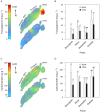Spatial and temporal dynamics of mass mortalities in oysters is influenced by energetic reserves and food quality
- PMID: 24551106
- PMCID: PMC3925110
- DOI: 10.1371/journal.pone.0088469
Spatial and temporal dynamics of mass mortalities in oysters is influenced by energetic reserves and food quality
Abstract
Although spatial studies of diseases on land have a long history, far fewer have been made on aquatic diseases. Here, we present the first large-scale, high-resolution spatial and temporal representation of a mass mortality phenomenon cause by the Ostreid herpesvirus (OsHV-1) that has affected oysters (Crassostrea gigas) every year since 2008, in relation to their energetic reserves and the quality of their food. Disease mortality was investigated in healthy oysters deployed at 106 locations in the Thau Mediterranean lagoon before the start of the epizootic in spring 2011. We found that disease mortality of oysters showed strong spatial dependence clearly reflecting the epizootic process of local transmission. Disease initiated inside oyster farms spread rapidly beyond these areas. Local differences in energetic condition of oysters, partly driven by variation in food quality, played a significant role in the spatial and temporal dynamics of disease mortality. In particular, the relative contribution of diatoms to the diet of oysters was positively correlated with their energetic reserves, which in turn decreased the risk of disease mortality.
Conflict of interest statement
Figures



Similar articles
-
Determination of risk factors for herpesvirus outbreak in oysters using a broad-scale spatial epidemiology framework.Sci Rep. 2018 Jul 18;8(1):10869. doi: 10.1038/s41598-018-29238-4. Sci Rep. 2018. PMID: 30022088 Free PMC article.
-
Detection and description of a particular Ostreid herpesvirus 1 genotype associated with massive mortality outbreaks of Pacific oysters, Crassostrea gigas, in France in 2008.Virus Res. 2010 Oct;153(1):92-9. doi: 10.1016/j.virusres.2010.07.011. Epub 2010 Jul 16. Virus Res. 2010. PMID: 20638433
-
Spatial distribution of mortality in Pacific oysters Crassostrea gigas: reflection on mechanisms of OsHV-1 transmission.Dis Aquat Organ. 2013 Jul 22;105(2):127-38. doi: 10.3354/dao02615. Dis Aquat Organ. 2013. PMID: 23872856
-
Haemocytes collected from experimentally infected Pacific oysters, Crassostrea gigas: Detection of ostreid herpesvirus 1 DNA, RNA, and proteins in relation with inhibition of apoptosis.PLoS One. 2017 May 18;12(5):e0177448. doi: 10.1371/journal.pone.0177448. eCollection 2017. PLoS One. 2017. PMID: 28542284 Free PMC article.
-
Detection of ostreid herpesvirus 1 DNA by PCR in bivalve molluscs: a critical review.J Virol Methods. 2007 Jan;139(1):1-11. doi: 10.1016/j.jviromet.2006.09.005. Epub 2006 Oct 31. J Virol Methods. 2007. PMID: 17079025 Review.
Cited by
-
Epigenetic variations are more substantial than genetic variations in rapid adaptation of oyster to Pacific oyster mortality syndrome.Sci Adv. 2023 Sep 8;9(36):eadh8990. doi: 10.1126/sciadv.adh8990. Epub 2023 Sep 8. Sci Adv. 2023. PMID: 37683000 Free PMC article.
-
Metabolism of the Pacific oyster, Crassostrea gigas, is influenced by salinity and modulates survival to the Ostreid herpesvirus OsHV-1.Biol Open. 2018 Feb 20;7(2):bio028134. doi: 10.1242/bio.028134. Biol Open. 2018. PMID: 29463513 Free PMC article.
-
Determination of risk factors for herpesvirus outbreak in oysters using a broad-scale spatial epidemiology framework.Sci Rep. 2018 Jul 18;8(1):10869. doi: 10.1038/s41598-018-29238-4. Sci Rep. 2018. PMID: 30022088 Free PMC article.
-
Rapid capture and detection of ostreid herpesvirus-1 from Pacific oyster Crassostrea gigas and seawater using magnetic beads.PLoS One. 2018 Oct 3;13(10):e0205207. doi: 10.1371/journal.pone.0205207. eCollection 2018. PLoS One. 2018. PMID: 30281676 Free PMC article.
-
Immunological Responses of Marine Bivalves to Contaminant Exposure: Contribution of the -Omics Approach.Front Immunol. 2021 Feb 18;12:618726. doi: 10.3389/fimmu.2021.618726. eCollection 2021. Front Immunol. 2021. PMID: 33679759 Free PMC article. Review.
References
-
- Lafferty KD, Porter JW, Ford SE (2004) Are diseases increasing in the ocean? Annu Rev Ecol Evol Syst 35: 31–54 10.1146/annurev.ecolsys.35.021103.105704 - DOI
-
- Mydlarz LD, Jones LE, Harvell CD (2006) Innate immunity environmental drivers and disease ecology of marine and freshwater invertebrates. Annu Rev Ecol Evol Syst 37: 251–288 10.1146/annurev.ecolsys.37.091305.110103 - DOI
-
- Samain J-F and McCombie H (2008) Summer mortality of Pacific oyster Crassostrea gigas, the Morest project.
Publication types
MeSH terms
Substances
LinkOut - more resources
Full Text Sources
Other Literature Sources

